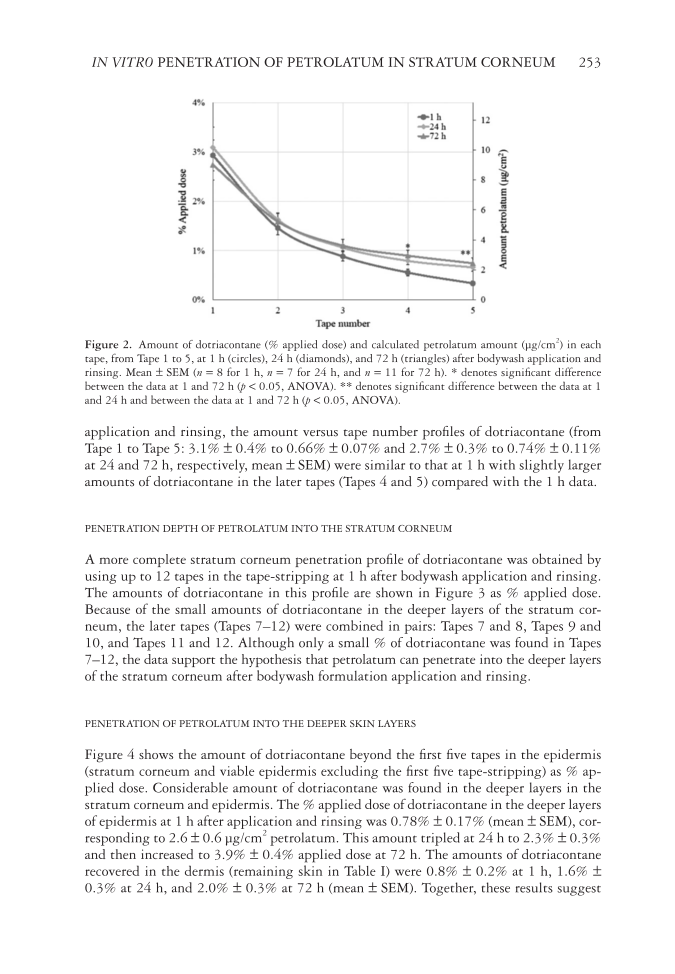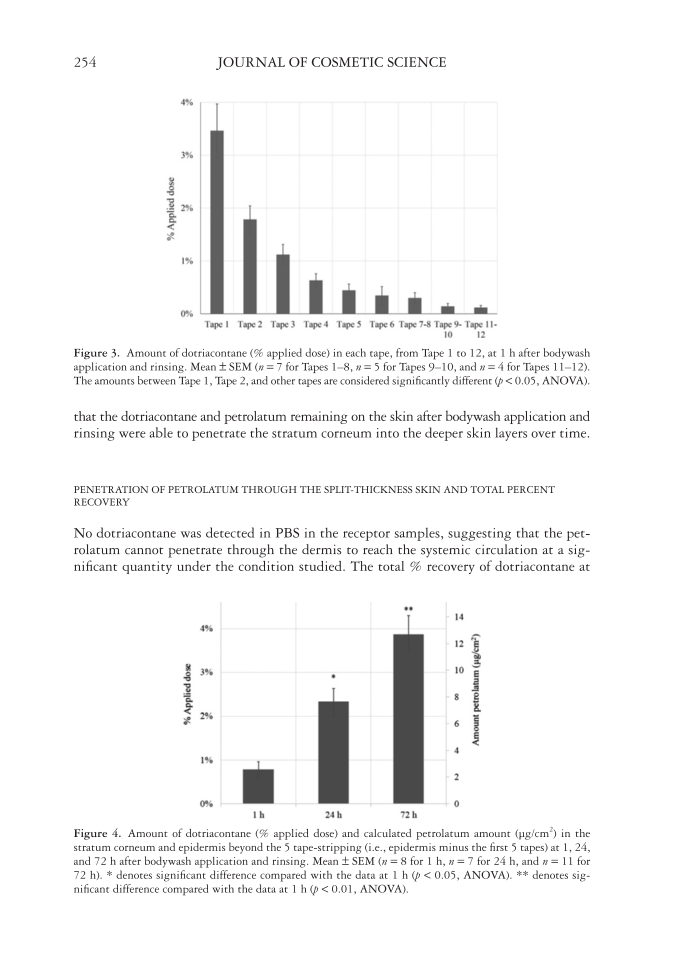IN VITRO PENETRATION OF PETROLATUM IN STRATUM CORNEUM 253 application and rinsing, the amount versus tape number profi les of dotriacontane (from Tape 1 to Tape 5: 3.1% ± 0.4% to 0.66% ± 0.07% and 2.7% ± 0.3% to 0.74% ± 0.11% at 24 and 72 h, respectively, mean ± SEM) were similar to that at 1 h with slightly larger amounts of dotriacontane in the later tapes (Tapes 4 and 5) compared with the 1 h data. PENETRATION DEPTH OF PETROLATUM INTO THE STRATUM CORN EUM A more complete stratum corneum penetration profi le o f dotriacontane was obtained by using up to 12 tapes in the tape-stripping at 1 h after bodywash application and rinsing. The amounts of dotriacontane in this profi le are shown in Figure 3 as % applied dose. Because of the small amounts of dotriacontane in the deeper layers of the stratum cor- neum, the later tapes (Tapes 7–12) were combined in pairs: Tapes 7 and 8, Tapes 9 and 10, and Tapes 11 and 12. Although only a small % of dotriacontane was found in Tapes 7–12, the data support the hypothesis that petrolatum can penetrate into the deeper layers of the stratum corneum after bodywash formulation application and rinsing. PENETRATION OF PETROLATUM INTO THE DEEPER SKIN LAYERS Figure 4 shows the amount of dotriacontane beyond the fi rst fi ve tapes in the epidermis (stratum corneum and viab le epidermis excluding the fi rst fi ve tape-stripping) as % ap- plied dose. Considerable amount of dotriacontane was found in the deeper layers in the stratum corneum and epidermis. The % applied dose of dotriacontane in the deeper layers of epidermis at 1 h after application and rinsing was 0.78% ± 0.17% (mean ± SEM), cor- responding to 2.6 ± 0.6 μg/cm2 petrolatum. This amount tripled at 24 h to 2.3% ± 0.3% and then increased to 3.9% ± 0.4% applied dose at 72 h. The amounts of dotriacontane recovered in the dermis (remaining skin in Table I) were 0.8% ± 0.2% at 1 h, 1.6% ± 0.3% at 24 h, and 2.0% ± 0.3% at 72 h (mean ± SEM). Together, these results suggest Figure 2. Amount of dotriacontane (% applied dose) and calculated petrolatum amount (μg/cm2) in each tape, from Tape 1 to 5, at 1 h (circles), 24 h (diamonds), and 72 h (triangles) after bodywash application and rinsing. Mean ± SEM (n = 8 for 1 h, n = 7 for 24 h, and n = 11 for 72 h). * denotes signifi cant difference between the data at 1 and 72 h (p 0.05, ANOVA). ** denotes signifi cant difference between the data at 1 and 24 h and between the data at 1 and 72 h (p 0.05, ANOVA).
JOURNAL OF COSMETIC SCIENCE 254 that the dotriacontane and petrolatum remaining on the skin after bodywash application and rinsing were able to penetrate the stratum corneum into the deeper skin layers over time. PENETRATION OF PETROLATUM THROUGH THE SPLIT-THICKNESS SKIN AND TOTAL PER CENT RECOVERY No dotriacontane was detected in PBS in the receptor samples, suggesting that the pet- rolatum cannot penetrate through the dermis to reach the systemic circulation at a sig- nifi cant quantity under the condition studied. The total % recovery of dotriacontane at Figure 3. A mount of dotriacontane (% applied dose) in each tape, from Tape 1 to 12, at 1 h after bodywash application and rinsing. Mean ± SEM (n = 7 for Tapes 1–8, n = 5 for Tapes 9–10, and n = 4 for Tapes 11–12). The amounts between Tape 1, Tape 2, and other tapes are considered signifi cantly different (p 0.05, ANOVA). Figure 4. Amount of dotriacontane (% applied dose) and calculated petrolatum amount (μg/cm2) in the stratum corneum and epidermis beyond the 5 tape-stripping (i.e., epidermis minus the fi rst 5 tapes) at 1, 24, and 72 h after bodywash application and rinsing. Mean ± SEM (n = 8 for 1 h, n = 7 for 24 h, and n = 11 for 72 h). * denotes signifi cant difference compared with the data at 1 h (p 0.05, ANOVA). ** denotes sig- nifi cant difference compared with the data at 1 h (p 0.01, ANOVA).
Purchased for the exclusive use of nofirst nolast (unknown) From: SCC Media Library & Resource Center (library.scconline.org)


















































